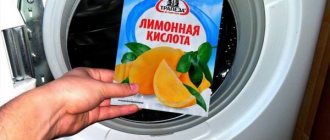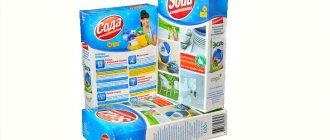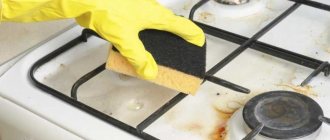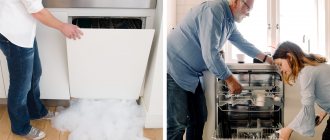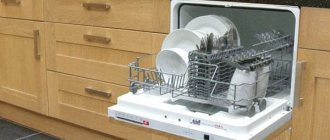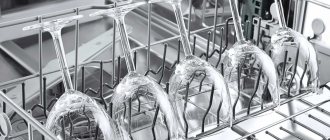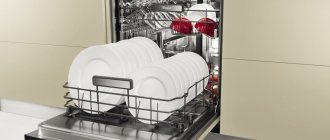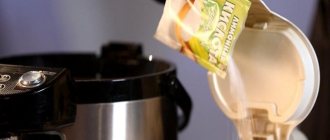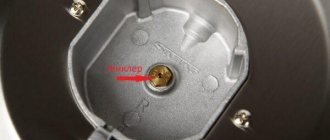Manufacturers advise cleaning your car about once a month. But this is a general recommendation. In your case, you may need to wash the device more often or less often. It depends on how exactly you are used to using the device.
Please note that the car gets dirty faster if:
- you turn it on once a day or more often;
- forget to leave the door open after washing (in this case, the internal elements of the machine take longer to dry and mold may appear on them);
- your water is too hard, but you forget to add special softening salt for the dishwasher to the compartment provided for this;
- load very dirty dishes - with burnt food, congealed fat, dried pieces of dough;
- run the wash at a low water temperature (for example, to save energy);
- are accustomed to using only gentle detergents that are simply not capable of removing serious stains;
- Place dishes that are not dishwasher safe, such as disposable or wooden ones, into the chamber.
However, even under such harsh operating conditions, the machine is able to remain clean for a long time. You can determine when it’s time to wash it based on certain signs.
How to know when it's time to clean your dishwasher
Here are a few main symptoms:
- Unpleasant odor from the working chamber.
- Poor dishwashing: plates, pots, and cups end up with whitish water stains or a greasy residue.
- Food particles are observed inside the chamber or on dishes removed from it.
- Rust and mineral deposits are visible on the internal surfaces of the tank.
- An indelible coating is visible on the filter and water spray blades.
- You notice that the water drains slower than usual or begins to leak.
If any of these signs appear, the car clearly needs a comprehensive cleaning. Be consistent.
How to Clean Dishwasher Baskets
Photo: Vladyslav Lehir / Shutterstock
Baskets are those lattice trays on which dishes are placed. Food debris, especially in the form of long fibers, and fat can accumulate on them.
What you will need
- Latex gloves.
- Soft microfiber cloths.
- Sponge for washing dishes.
- An old toothbrush with soft bristles.
- Cleaning solution. The easiest way to prepare it is to dissolve a couple of tablespoons of dishwashing liquid in a liter of warm water.
- Pure water.
What to do
Remove the baskets from the guides, if possible, and soak them in the cleaning solution for a few minutes. Fixed elements will have to be washed directly in the car, pushing them out as far as possible.
Remove any large food debris. Then use a sponge to thoroughly wipe the grates on all sides. Use a toothbrush to clean hard-to-reach areas in the crooks of the baskets.
Shot: @Miss Clean / YouTube
Rinse the baskets with clean water. Wipe with tissues to remove excess moisture. Reinstall the parts if you removed them.
Removing scale using folk remedies
Experienced housewives primarily use available means to prevent contamination. Try cleaning your dishwasher with similar substances.
Citric acid
Citric acid is very active and can destroy the elasticity of pads, so use the product no more than once a year.
- Pour 150–200 g of citric acid into the machine hopper.
- Run a wash cycle without dishes.
- When the process reaches halfway, stop the wash, wait a little, and then turn it on again.
If there is a large clog, the acid will cause the debris to flake off in large pieces, which can result in the drain filter becoming clogged.
Vinegar
Vinegar, like citric acid, cleans machine parts by acid. To clean your device:
- Pour 400 ml of product throughout the hopper.
- Treat all walls and cracks with it.
- Start washing and stop the dishwasher for half an hour during operation.
- Resume work and wash everything with detergent when finished.
- Run the washer again to remove any remaining vinegar.
Borax for scale
The product can be used on all interior surfaces of the dishwasher where plaque forms.
Progress:
- Apply borax to a sponge and work around the sides, baskets and door, but do not rub.
- Start any wash cycle with high water temperature and wait until it finishes.
- Check the structure for plaque and borax, and restart the wash if necessary.
Soda and peroxide
A product made from soda with hydrogen peroxide has an active effect on pollution. To clean the machine:
- Mix 350 g of soda with 3 tbsp. spoons of hydrogen peroxide.
- Form a ball from the resulting mass and throw it into the machine’s hopper.
- Run a long washing process with high preheating temperature.
- If plaque remains after treatment, repeat the procedure.
Usually, even with severe blockages, several procedures are sufficient.
Salt
If the contamination is severe, salt will have little effect, so it is used for prevention. Once a week, fill the machine's hopper with it and rinse without using dishes. Salt blocks oxidation and scale buildup.
How to clean dishwasher filters
Some manufacturers recommend cleaning these elements after each dishwashing. The fact is that the filter system traps food particles to prevent them from clogging the drain. If this debris is not removed promptly, it decomposes and can cause an unpleasant odor. In addition, dirty filters make it difficult to drain water from the machine.
What you will need
- Latex gloves.
- Soft microfiber cloths.
- Screwdriver - optional.
- Sponge.
- Dishwashing liquid.
What to do
Unplug the dishwasher and close the water supply valve.
Pull out the strainer. It is usually located on the bottom panel of the dishwasher, next to the water spray blades.
Shot: @Oleg Home&Family / YouTube
If you have a modern dishwasher, removing the filter will not be difficult: just pull it up a little or unscrew it. On older models, you may need to use a screwdriver.
Shot: @Oleg Home&Family / YouTube
Inspect the filter for contamination. Remove any larger pieces of food and other debris, such as pieces of plastic utensils.
Rinse the part under warm running water. If the parts have a lot of grease, use a sponge and dishwashing detergent.
Blot the clean filter with an absorbent cloth to remove excess moisture and reinstall. Make sure that the marking arrows on the bottom of the dishwasher and on one side of the part point to each other after installation.
Removing grease, mold and scale
If you notice that a whitish coating has appeared on the dishes or the inner walls of the appliance, or an unpleasant odor begins to emanate from the box, you need to urgently start cleaning the machine.
And the best helpers here will be ready-made solutions made by machine manufacturers. The means at hand, which are likely to be found in the kitchen of any housewife, will also come in handy.
Use of ready-made chemicals
To wash the dishwasher and its internal elements that are inaccessible to simple mechanical cleaning, it is recommended to run the device on any long cycle at high temperature with the addition of a cleaning agent.
But if you notice yellow or rusty spots on the inner surfaces of the dishwasher, the cause may also be a high iron content in the water. In this case, you will have to install a special filter on the inlet hose.
Fresh stains can be removed with a rag soaked in stainless steel cleaner, but old rust is best treated with an anti-corrosion coating after washing.
Bottled Finish is a universal dishwasher cleaner that is placed neck down in an empty tray, and the machine is run for a full cycle at a temperature of 65 degrees.
The most popular chemicals for disinfection and descaling:
- Finish Machine Cleaner - under the influence of hot water, the membrane on the neck of the bottle dissolves, and the product actively cleans all accessible surfaces from grease, scale and unpleasant odors.
- Antiscale - degreasing powder for removing lime deposits and scale on the internal elements of the machine.
- FILTERO is a liquid for the preventive cleaning of dishwashers from grease and scale.
- ELECTROLUX is a liquid product for removing fat deposits and small food debris, as well as anti-scale powder and flavoring.
These drugs work on a similar principle - they are placed in an empty dishwasher, then the device is turned on for 45-90 minutes at high temperature. Afterwards, it is recommended to run the rinsing again dry, for a short cycle, to ensure that all chemical residues are removed, and wipe the surfaces dry with a soft cloth.
A clear example of the excellent performance of a professional product is the inner surfaces of the dishwasher before and after cleaning with Finish Machine Cleaner
In addition, you can use specialized sprays and liquids recommended for cleaning and polishing the stainless walls of the dishwasher, and to combat unpleasant odors - flavors that are hung on the baskets of the device and can be used over several cycles.
But manufacturers do not recommend adding dishwashing liquid for preventative washing and degreasing of the surface.
The fact is that increased foaming can damage the internal elements of the device, and attempts to save money will end in repairs. Therefore, it is possible and necessary to manually wipe surfaces in a soap solution, but you should not run the machine with the addition of a foaming liquid.
Alternative to purchased products
Professional preparations are good for their balanced composition and complex effect on the three most common problems of machines - scale, odor and grease deposits. But if you are looking for a way to quickly clean your dishwasher and save money at the same time, we offer several recipes using inexpensive but effective ingredients.
Baking soda, vinegar and lemon acid are the most famous helpers for housewives in the fight against limescale, rust stains and grease film.
To clean the machine, and at the same time the drain from fatty deposits, you need to pour 1.5-2 cups of vinegar into a cup or plate. Then they should be placed in the upper tray, soda should be poured on the bottom and any long mode should be started.
And as soon as the water heats up, press pause and leave the device for at least 30 minutes (but preferably overnight). During this time, various dried debris and plaque will soften and can be easily removed along with dirty water.
Another universal remedy that will help remove traces of scale is citric acid. Its consumption depends on the displacement of the car and the degree of contamination, but on average you will need about 150-200 grams. It also works at high temperatures, and for better effect - with a forced stop of the device from 30 minutes to several hours.
Although lemon powder is really good at removing scale and cleaning the nozzles in the powder cuvette, this cleaning method is very controversial, since concentrated acid can damage the seals of the device
There is also a more gentle way - prepare a solution from water and vinegar or lemon powder, pour it into any bottle with a spray bottle and use it to manually clean the inner walls of the box and other surfaces with scale. In this case, you need to spray the product carefully and make sure that it does not get on the rubber elements or on the skin.
You can make “2 in 1” tablets from soda, which will not only help clean your car from grease and dirt, but also refresh the air with a pleasant aroma.
Cooking method:
- Pour 10-15 drops of any essential oil and 1-2 tablespoons of hydrogen peroxide into a glass with powdered soda.
- Mix everything with a spatula - the mixture should look like wet sand.
- Using an ice cream spoon or scoop, form small balls.
- Place the prepared tablets on the bottom of the device.
- Run the dishwasher on a long cycle.
For the best effect, users recommend placing a plate with 1-2 glasses of vinegar in the basket.
How to clean dishwasher spray arms
Sprayers, or spray arms, ensure the flow and uniform distribution of water inside the dishwasher chamber. If they are clogged, the dishes will not be washed properly: stains and greasy marks will remain on them.
What you will need
- Latex gloves.
- Tweezers or toothpick.
- Microfiber cloths.
- Sponge.
What to do
Carefully inspect the openings (nozzles) of the spray arms from which water flows for contamination.
Shot: @Oleg Home&Family / YouTube
If you see dirt or food debris, try removing it with tweezers or a toothpick. But under no circumstances push debris into the nozzles!
If the parts are heavily soiled, remove the lower and upper nozzles as indicated in the machine instructions. Most often, the upper blade unscrews, and the lower one can be removed by simply gently pulling it up.
Rinse parts under warm running water, using a sponge if necessary. Then wipe the blades with napkins and put them in place.
Anti-lime products
Industrial descalers are good because they contain cleaning agents in the optimal ratio. They allow you to clean your dishwasher from grease, lime and mildew all at once. On the packaging, the manufacturer indicates the required dosage, holding time and temperature conditions to achieve maximum effect. It is important not to overexpose the “chemistry” inside the device so that it does not damage the internal parts. One dry wash cycle of 40 minutes or more is sufficient.
Frau Schmidt tablets
Water-soluble tablets are used for comprehensive cleaning of the dishwasher from scale, fungus, grease and food waste. The manufacturer recommends cleaning the device once every 6 months with soft water and once every 3 months with hard water.
Directions for use: 1 tablet is freed from the film and placed in the dispenser of an empty machine. Select a washing program without pre-rinsing at 60 °C.
Ingredients: sodium bicarbonate, citric acid, trisodium citrate, other additives.
Top House
Gel for cleaning Bosch cars and other models quickly and efficiently removes grease and scale, cleans spray nozzles and drain hoses, and destroys blockages in drain hoses. It is recommended to use the product every 1-2 months.
Directions for use: Install the cleaner in an empty dishwasher. To do this, remove the top sticker without unscrewing the lid or tearing off the wax layer. The bottle turned upside down is attached to the device basket. Start the washing mode at a temperature not lower than +65°C.
Ingredients: nonionic surfactants, flavors, corrosion inhibitor, organic acid.
Clean Home
Biodegradable liquid for removing scale and unpleasant odors is created from components that are safe for humans. Preventive cleaning is carried out depending on the intensity of use of the machine.
Directions for use: The contents of the bottle are poured directly into the chamber of an empty machine. Set a program with a minimum temperature of +60°C and let the machine complete it completely.
Ingredients: water, citric acid, polycarboxylates, lactic acid, Amsurfactants, functional additives.
Electrolux
The granular product cleans the dishwasher from limescale, reduces energy consumption and ensures long service life of the appliance. For greater effect, the manufacturer recommends using Electrolux degreaser first. Cleaning is carried out 2-4 times a year, depending on the degree of water hardness.
Directions for use: pour the entire contents of the package directly into the empty appliance and start the washing cycle at +50 °C without dishes.
Composition: nonionic surfactants.
How to clean seals and dead spots in your dishwasher
Grease, food debris and other debris accumulate not only on filters and open surfaces of the device, but also in hard-to-reach places. For example, on the rubber gaskets between the door and the body.
In addition, debris can get into the lower part of the door - the so-called dead zone, where water does not penetrate during washing. This may cause an unpleasant odor.
What you will need
- Latex gloves.
- Dishwashing liquid.
- Sponge.
- Toothbrush with soft bristles.
- Microfiber cloths.
- Water.
What to do
Carefully inspect the seals and the bottom of the door. Remove large, visible debris.
Then wipe the elements with a sponge with detergent applied to it. If dirt is difficult to reach, use a toothbrush.
Wash the seals and the “dead zone” with a cloth soaked in clean water. Wipe dry.
Tips for care and use
It is recommended to carry out comprehensive cleaning of the machine at least once a month, and flush the filtration system weekly.
But in order to reduce the amount of work during general cleaning, we recommend taking note of a few simple tips for regular care and use:
- Place dishes in trays in accordance with the manufacturer's layout. General recommendations, however, are the same for all appliances - frying pans, pots, baking trays with carbon deposits and other heavily soiled or large dishes are always placed at the bottom - washing is more active there. And glasses, cups and deep plates must be turned upside down so that no powder or water remains in them.
- Before loading, wipe the dishes from large debris with a regular napkin.
- Use regenerating salt in addition to detergent powder or tablets that already contain softener.
- After each cycle, remove the coarse filter mesh and remove accumulated debris.
- Check the detergent compartment to ensure there is no powder or pieces of tablets left in it.
Use only non-metallic objects and soft rags for cleaning - hard fibers can damage the protective coating of the box or baskets and give the green light to rust.
The video will introduce you to the features of cleaning a dishwasher using home remedies and the cooking method:
To avoid a musty smell, always wipe the internal elements with a dry cloth after each start-up and ventilate the device until the condensation evaporates.
And the last tip is to use the dishwasher at least 3-4 times a week. Paradoxically, the longer the device remains idle, the shorter its service life will be, since such downtime more often causes problems with blockages, limestone and unpleasant odors.

